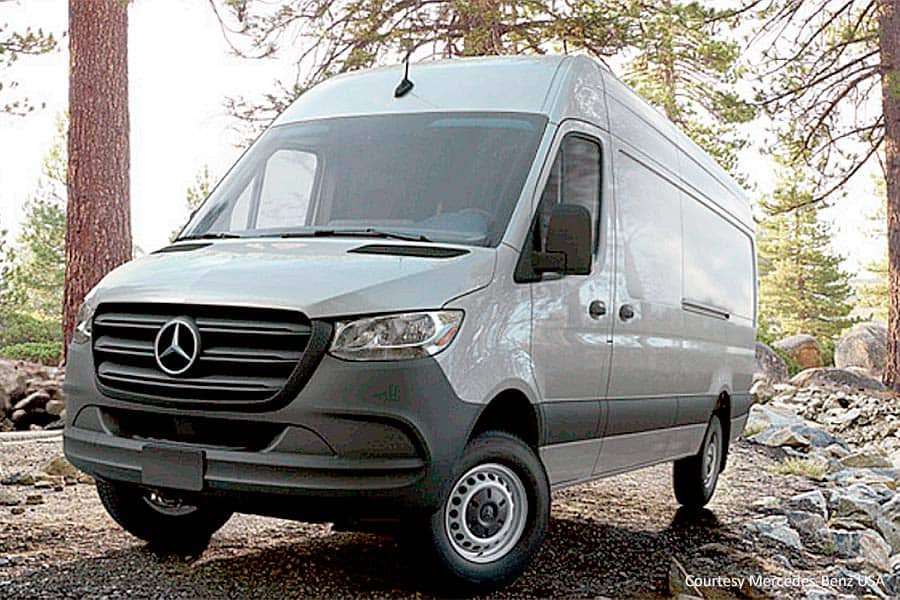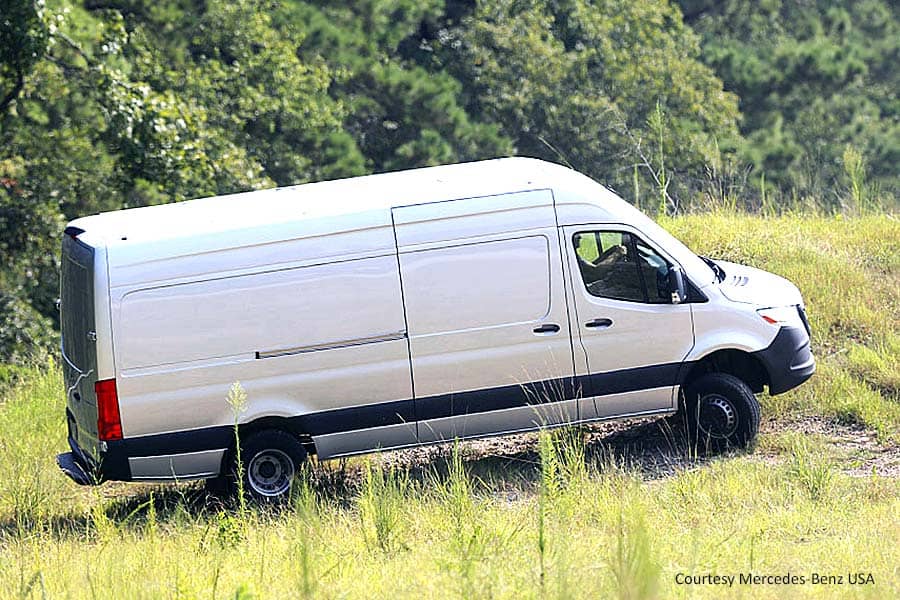
The Mercedes-Benz Sprinter is one of the most popular vans on the market. Not a day goes by that you won’t see a Sprinter on the road, whether it’s delivering packages, hauling passengers to the airport, bringing a work crew and their equipment to a job, or living a new life as a Class B RV. But there are many different versions of this legendary vehicle. But, what’s the difference between the Sprinter 2500 and 3500?
The differences between the Sprinter 2500 and 3500 are many, as both have multiple options packages available. Overall, the 3500 series is more powerful and runs almost exclusively on diesel; the 2500 series is slightly less powerful but comes in a wide array of builds.
That’s a pretty vague answer, and clearly, there’s a lot left to unpack here. The Mercedes-Benz Sprinter 2500 and 3500 are both legends in their own right, and the differences between the two range from blindingly obvious to strikingly subtle. These vans are genuinely remarkable machines; continue reading to find out some of the actual differences.
Mercedes-Benz Sprinter 2500 and 3500 – Breaking down the Differences
Before we break down the differences between the 2500 and 3500 Sprinter vans, let’s talk about the things they have in common. Both models are 79.5″ wide and include standard safety features like adaptive cruise control, active brake assist, airbags, automatic headlights, hill start assistance, and a computer-controlled load-adaptive electronic stability program. Both of these Sprinters also are certified for ULEV/SULEV emissions.
Now let’s talk about differences. The 2500 and 3500 come with differing engine models, dimensions, wheelbases, and configurations. For example, the 3500 is available with a dual rear-wheel configuration, and the 2500 is not. Making it even more complicated, there are nine total Sprinters available in the 2500 and 3500 lines!
Let’s sort out the distinctions between these models. We’ll describe the models by number, wheelbase (WB), and whether or not the model is extended. We’ll also annotate any models available with dual rear tires as duallys.
The Nine Sprinter Models Are:
- 2500, 144″ WB
- 2500, 170″ WB
- 2500, 170″ EXT WB
- 3500, 144″ WB
- 3500, 170″ WB
- 3500, 170″ EXT WB
- 3500 Dually, 144″ WB
- 3500 Dually, 170″ WB
- 3500 Dually, 170″ EXT WB
From now on, we’ll arrange this information so it is easier to compare. Let’s look at some Sprinters!
Dimensions
The Sprinter is available in an assortment of dimensions, depending on the specific model you get. The standard length is 233.5″, or about 19 feet. Extended length models can be as long as 24 feet. Roof heights range from 8 feet to about 9 feet off the ground. And of course, duallys have an extra rear tire on each side for those heavy-duty applications, which makes them a little wider than singles.
- 2500, 144″ – 233.5″ long; 96.3″ to 111.3″ high
- 2500, 170″ – 274.3″ long; 107.3″ to 110.9″ high
- 2500, 170″ EXT – 290″ long; 107″ to 110.5″ high
- 3500, 144″ – 233.5″ long; 109.4″ high
- 3500, 170″ – 274.3″ long; 109.1″ high
- 3500, 170″ EXT – 290″ long; 108.7″ high
- 3500 Dually, 144″ – 233.5″ long; 96.4″ to 109.1″ high
- 3500 Dually, 170″ – 274.3″ long; 108.7″ high
- 3500 Dually, 170″ EXT – 290″ long; 108.4″ high
Related Posts
- What RVs Are Built On A Mercedes-Benz Sprinter Chassis?
- The Cost Of Converting A Sprinter Van Explained
- Ram ProMaster vs. Mercedes-Benz Sprinter: Which Is Right For You?
- How To Pack A 4×4 For Camping: A Comprehensive Guide

Engine and Fuel
Sprinters come with three basic engines. First, a 2-liter, 4-cylinder, Turbocharged gasoline engine that produces 188 horsepower and 258 foot-pounds of torque. This option has a 22-gallon fuel tank and takes regular 87-octane fuel.
There are two diesel engines available for Sprinters. The first is a 3-liter, V6 Turbo diesel engine that produces 188 horsepower and a solid 325 foot-pounds of torque. This engine burns regular diesel and has a 24.5-gallon fuel tank. The second diesel engine is a 2-liter, inline-4 that produces 161 horsepower and 266 foot-pounds of torque. Like its sister engine, it burns regular diesel and stores 24.5 gallons of fuel.
- 2500, 144” – Gasoline or Diesel
- 2500, 170” – Gasoline or Diesel
- 2500, 170” EXT – Diesel only
- 3500, 144” – Diesel only
- 3500, 170” – Diesel only
- 3500, 170” EXT – Diesel only
- 3500 Dually, 144” – Diesel only
- 3500 Dually, 170” – Diesel only
- 3500 Dually, 170″ EXT – Diesel only
Payload Capacity
A critical consideration for a potential RV conversion is payload capacity. After all, one needs to account for the weight of water tanks, bunks, storage, gear, furnishings, and the necessary wiring and plumbing to accommodate them. Payload capacity varies with engine and powertrain options, but the info below should give you a good idea of the expected payload capacity for these vehicles.
- 2500, 144” – 3,825 to 4,442 pounds
- 2500, 170” – 3,318 to 4,034 pounds
- 2500, 170” EXT – 3,318 to 3,726 pounds
- 3500, 144” – 4,488 to 4,554 pounds
- 3500, 170” – 4,125 to 4,201 pounds
- 3500, 170” EXT – 4,069 to 4,124 pounds
- 3500 Dually, 144″ – 4,488 to 4,620 pounds
- 3500 Dually, 170″ – 4,135 to 4,190 pounds
- 3500 Dually, 170″ EXT – 4,058 to 4,113 pounds

Towing Capacity
When we go RVing, we might want to bring along bikes, jet skis, a smaller car, or any number of towable accessories. How much can these vehicles tow? This category is easy: all Sprinter 2500 models can tow up to 5,000 pounds, and all Sprinter 3500 models can tow up to 7,500 pounds.
GVWR
The Sprinter 2500 GVWR is no more than 9,050 pounds. The Sprinter 3500 GVWR is no more than 9,900 pounds.
Turn Radius
The Sprinter is supposed to handle well and be nimble, but how nimble is it? Can it turn on a dime, or does it need a half-dollar? Figures listed here are curb-to-curb turn radii, meaning that it will require this many feet to make a 180-degree turn in a Sprinter without bumping a curb. Some models will have a range, which is dependent on other build options such as overall length and engine.
- 2500, 144” – 40.7′ to 43.3′
- 2500, 170” – 47.2′ to 50.2′
- 2500, 170” EXT – 47.2′ to 50.2′
- 3500, 144” – 45.3′
- 3500, 170” – 52.5′
- 3500, 170” EXT – 52.5′
- 3500 Dually, 144” – 45.3′
- 3500 Dually, 170” – 52.5′
- 3500 Dually, 170” EXT – 52.5′
For comparison’s sake, a Toyota Camry can make a 180-degree turn in about 19 feet.
4X4
Sometimes, we might want to take our RV to a more remote destination. More adventurous souls might even wish to take their RV off-road and camp out in the bush somewhere. Which Sprinter models are available as a 4X4?
- 2500, 144″ – 4X2 with gasoline engine; 4X4 with diesel engine
- 2500, 170″ – 4X2 with gasoline engine; 4X4 with diesel engine
- 2500, 170” EXT – 4X2 or 4X4
- 3500, 144” – 4X2 only
- 3500, 170” – 4X2 only
- 3500, 170” EXT – 4X2 only
- 3500 Dually, 144” – 4X2 only
- 3500 Dually, 170” – 4X2 only
- 3500 Dually, 170” EXT – 4X2 only
Stabilization Features
2500 model Sprinters come with available Level II Stabilization features. These are essentially roll stabilizers and dampers that are attached to the axle to prevent rollover by absorbing compression and rebound to keep the vehicle from toppling.
3500 model Sprinters come with available Level III stabilization. They are built to handle heavier loads and may therefore be a little more likely to tip or sway, so Mercedes took the existing stabilization systems and beefed them up to handle the extra load.
Both of these stabilization systems work well. Unless you are driving erratically or tackling terrain that is truly inappropriate for an RV, your Sprinter will maintain stability on and off the road.
Would the 2500 or the 3500 Make a Better Camper Van?
Based on the information we’ve discussed today about the Sprinter 2500 and Sprinter 3500, it’s fair to say that any of these specific models would probably make an excellent camper van conversion.
However, overall, we think that the Sprinter 2500 170″ with a diesel engine and a 4X4 powertrain would be the best overall candidate for a camper van conversion. The engine is efficient and powerful, and the 4X4 adds traction and expands the possibilities of where you could take this vehicle. The 3,417-pound payload should allow you to bring almost anything you need, and the interior volume is spacious.
Sprinting Away to a New Day
When it comes to the Sprinter, there really is not a wrong choice. This van is thoughtfully designed and well built. Many commercial companies such as Winnebago use the Sprinter chassis as a base for their RVs. For those who wish to convert a van to an RV, the Sprinter is a strong choice and one you’ll never regret.






